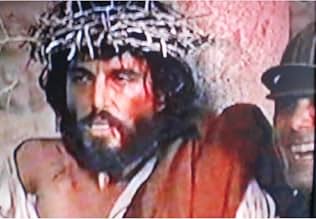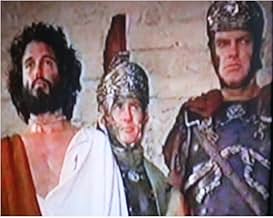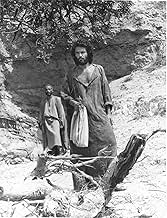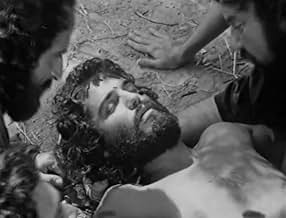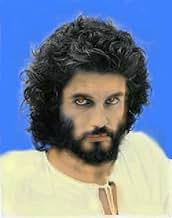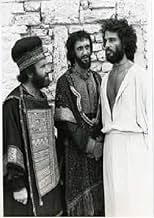Adicionar um enredo no seu idiomaThe Crucifixion of Christ seen more from a political and historical point of view than a spiritual one.The Crucifixion of Christ seen more from a political and historical point of view than a spiritual one.The Crucifixion of Christ seen more from a political and historical point of view than a spiritual one.
- Direção
- Roteiristas
- Artistas
- Direção
- Roteiristas
- Elenco e equipe completos
- Produção, bilheteria e muito mais no IMDbPro
Avaliações em destaque
This film is very depressive. I think who wrote him/it and it accomplished him/it certainly it doesn't believe that Jesus Christ resurrected and it arose to the heaven. In this film they are shown the last 24 hours of Jesus of Nazareth (Chris Sarandon). He begins with their disciples Peter and John going the city of Jerusalem, to find a place to prepare the dinner of Easter, following by the Last Supper, the prayer, the betrayal and the prison in the garden of Gethsemani, the judgement before the one of Highest Priest Caiaphas and of the main priests, Peter's denial, the interrogation before Pilate, the judgement in which the people choose Barabbas to be freed in Jesus' place, the flagellation, the coronation of thorns, the mockeries done by the Roman soldiers, the via-crucis (in the which Jesus only carries a part of the cross and no the cross completes) and it finishes when Jesus has his/her hand preached by the torturer in the log of the cross, and the image frozen there. The following image is the in that it shows Caiaphas and Pilate tends a fast conversation, saying that it is everything finishing and one wanting Happy Easter for the other,... and end. This film has an exquisite and detailed production, sceneries of the streets, of the houses, of the palaces, characterization and clothes of the guards of the Temple, of the soldiers and Roman centurions, of the priests, of Pilate, of the people, in a way that I think it must really have been at Judea and in Jerusalem 2000 years ago. And this film was faithful to the text of the Gospel in some parts, but in other the increment of scenes and of speeches, it fled completely to the sacred text, distorting completely. Judas, the traitor, nor it seems to be with total certainty of the one that intends do. But the great flaw of this film was without a doubt showing Jesus' last 24 hours, their judgement, suffering in an extremely heavy and depressive way, much more than in the other films on Christ that I saw. As for actor Chris Sarandon, until he interpreted Jesus Christ with plenty of competence, but it is not adapted for the paper. He is the first actor to represent Jesus Christ, without having the traditional characterization as all we knew of Jesus. Chris Sarandon doesn't have the long hair as it demands the paper. I don't agree with a film that doesn't show Jesus resurrecting, appearing to the disciples and arising to the heavens. In this point I give note 0 for the idealizadores, the producers and the enterprising of this film.
Which will the intention of the enterprising ones have been and producing with this film?
Which will the intention of the enterprising ones have been and producing with this film?
No doubt Mel Gibson watched this movie before he made his Passion, the similarities are clear. But what a joke! As a Jew who is NOT a Christian, but is a historian. I can tell you that I have never seen such a bad movie on the Jesus myth. Also, why is the Sanhedrin, the body of Jewish rabbis shown as a group of bumbling fools? The Sanhedrin were the top of the top of the intellectuals and scholars. If anything, the Romans who had near no education should have been the ones who looked like fools. Why are these Jews from ancient times wearing modern Jewish prayer cloths (Talletot)? And to have them hanging over their left shoulder only? Makes no sense at all. Also, the Sanhedrin is standing in a room surrounded by 9th century Morrish woodcut motifs. I would call this "Passion-Lite" because it is just as inaccurate as Gibson's movie, only it was done 24 years earlier.
It is a dialogue . Not the touching film, not the example of accuracy, not the lesson about The Savior. Just a honest dialogue about sensitive aspects of His last days and about the people motivations and gestures and expectations around Christ. Surprising fresness and the inspired slow rhytm are the basic virtues of a film proposing the reflection and not the show. Chris Sarandon propose a portrait who you feel as deep authentic. The dialogues are inspired crafted. And, not the last, its deep honesty is the great virtue , proposing not a vision but a provocative frame for old questions and sketches for significant posible answers. So, a beautiful, in special sense, film.
This movie is one of the most provocative Jesus movies I have ever seen. It does not seek to tell the whole story, but only to portray an interpretive expression of the last day of Jesus Christ. It is darkly witty, playful and seriously faithful to elements of the Jewish tradition and to modern scriptural interpretation. Judas is much more ordinary than other portrayals, not the dark and sinister evil that we sometimes imagine, but a grossly mistaken man, horribly misguided in his zeal. Chris Saranden's Jesus is playful and serious, faithful and committed--very human while also divine. The final dialog is thoughtfully done and serves as the kind of small talk that two powerful men might do when they have just committed an atrocity. I would watch this movie again and recommend it to others.
This is the most depressing film on Jesus Christ that I already viewed. Not only the most depressing, but I force (I don't eat Passion of the Christ of Mel Gibson, it is clear). Until today I don't understand which was the intention of the producing of do a film as this, different from all the other films on Christ done already. Here in this film Jesus (Chris Sarandon) it is just shown as human man, and no divine, that it is determined until the end in accomplishing his/her mission. It is also with physical lines (little accepted by most of the people) like Jesus it was very probably: a brunet man, of dark brown eyes, of rustic appearance, and not of hair blond or brown clear, of delicate face and of blue eyes as most imagines, in short, in this film Jesus is shown as a natural man from Palestine of the first century of ours was and not with European lines, as they were Franco Zeffirelli's Jesus in "Jesus of Nazareth" and of "King of Kings." And he was not shown like a solemn Jesus, reverent as it was in the other films, but a more human Jesus totally naked of any divinity. The same I say of Last Supper scenes and prayer in the garden of Gethsemani. In the scenes of the judgment, of the flagellation, Jesus is treated with such a ferocious hate shown never in other films. Jesus is viewed as somebody that has be punished severely and dead the more quickly in a more intense way than in other films. I remember of the scene, in that Caiaphas says Jesus soon at the end of the judgment: "And you don't forget that you are a Jew! " It is also of the scenes In that king Herod says for Jesus: "You are not a king of anything!!! Monarch of anybody!!! That more ridiculous king you would be!!!! " And all make fun of Jesus. Before "Passion of the Christ" of Mel Gibson, this had been the most violent film on the last of Jesus that it had already viewed. In this film Jesus is treated with end hate, contempt and ridiculed in such a cruel and merciless way that he left me very impressed and it finishes completely defeated, treaty as the vilest and despicable of all the criminals. I didn't like nor a little of this film. This film is very depressing, revolting and sad...
Você sabia?
- CuriosidadesBoth Tony Vogel(Temple Guard) and Keith Michell(Pontius Pilate) have been also involved in three other Biblical portrayals.....Vogel portrayed Andrew in Jesus Of Nazareth in 1977 and in 1999 TV movie Jesus portrays a farmer.....Michell portrayed Jacib in 1974 in The Story of Jacob and Joseph and in 1977 portrays King David in The Story of David.
- Cenas durante ou pós-créditosThe 20th Century Fox Television logo is shown without the fanfare.
- ConexõesReferenced in Saturday Night Live: Richard Benjamin, Paula Prentiss/The Grateful Dead (1980)
Principais escolhas
Faça login para avaliar e ver a lista de recomendações personalizadas
Detalhes
- Data de lançamento
- País de origem
- Idioma
- Também conhecido como
- El día en que murió Cristo
- Locações de filme
- Tunísia(filmed entirely on location in Tunisia)
- Empresa de produção
- Consulte mais créditos da empresa na IMDbPro
- Tempo de duração
- 2 h 22 min(142 min)
- Cor
- Proporção
- 1.33 : 1
Contribua para esta página
Sugerir uma alteração ou adicionar conteúdo ausente

